Exploring Orkney’s rugged landscapes and history, we were captivated by the Brough of Birsay walk.
This island, accessible only during low tide, offers a walk that reveals the intertwining of nature’s might and the resilience of ancient civilizations.
The Brough of Birsay Walk is a journey back in time, guided by the island’s dramatic cliffs, teeming with seabirds and windswept vistas.

While Living in Scotland, we always looked for places that blended natural beauty with historical richness. Locals pointed us towards the Brough of Birsay, emphasizing it as a jewel in Orkney’s crown that no visitor should skip.
Their insights were invaluable, turning our mid-May visit into an exploration of Pictish ruins, Norse heritage, and breathtaking clifftop views.
This guide is crafted to share with you the essence of the Brough of Birsay Walk, incorporating local wisdom to ensure you capture the full splendour of this unique Orkney experience.
From ancient settlements to the vibrant birdlife that adorns its cliffs, we invite you to discover why this walk is worth adding to your Orkney Itinerary.
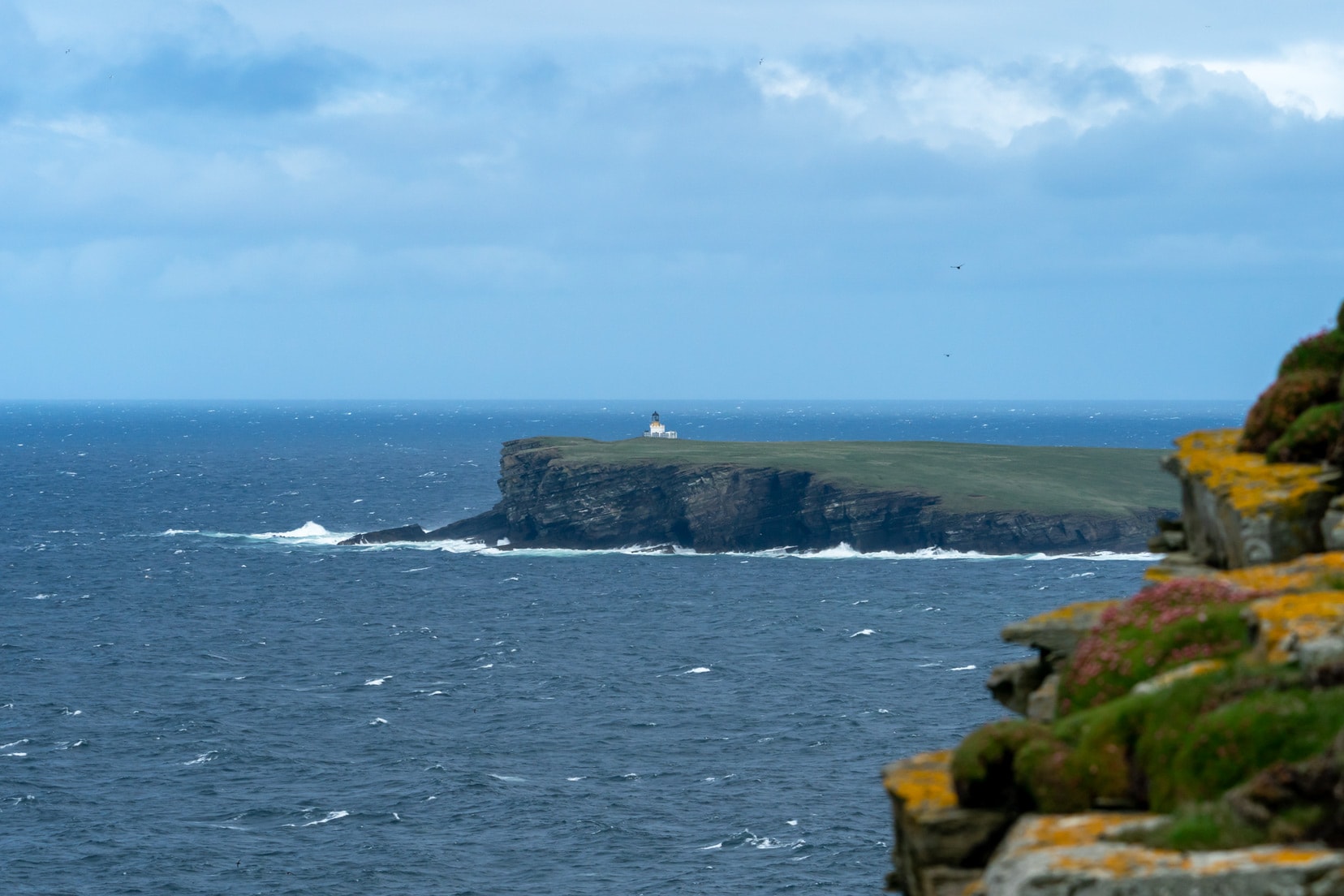
Brough of Birsay Walk: In a Nutshell 🥜
In a Hurry? Here’s What You Need to Know about the Brough of Birsay Walk:
- Accessibility: Only during low tide, check tide times.
- Location: Accessible via a 100m concrete causeway from mainland Orkney.
- Parking: Available at Point Buckquoy, opposite the island.
- Walks: Two main walks – exploring the island’s heart and the Skiba Geo footpath.
- Wildlife: Home to seabirds like puffins, razorbills, and gannets. Best wildlife spotting from April to July.
- Flora: Spring and summer bring wildflowers like pink thrift and yellow bird’s-foot trefoil.
- Historical Sites: Norse ruins, medieval chapel, and the Brough of Birsay lighthouse.
- Photography Tips: There are often windy conditions, so a tripod is recommended.
- Sustainability: Follow ‘Leave No Trace’ principles to help preserve the area.
- Local Amenities: Birsay Bay Tearoom near the Earl’s Palace offers refreshments.
- Tide Times: Essential for planning your visit. Check the UK Met Office or local leaflets for accurate times.
- Visitor Centre: Open mid-June to the end of September for deeper historical insights.
- Local Tour Guide:🥾 Book a flexible tour with a local guide to include the Brough of Birsay
- Local Tip: Pronunciation – ‘Brough’ as ‘brock’, ‘Birsay’ as ‘burrsay’.
Brough of Birsay Walk
Discover the Brough of Birsay through two captivating walks, each offering a unique perspective of this ancient island.
Locals recommend these routes, which promise an immersive journey into Orkney’s natural beauty and historical richness.
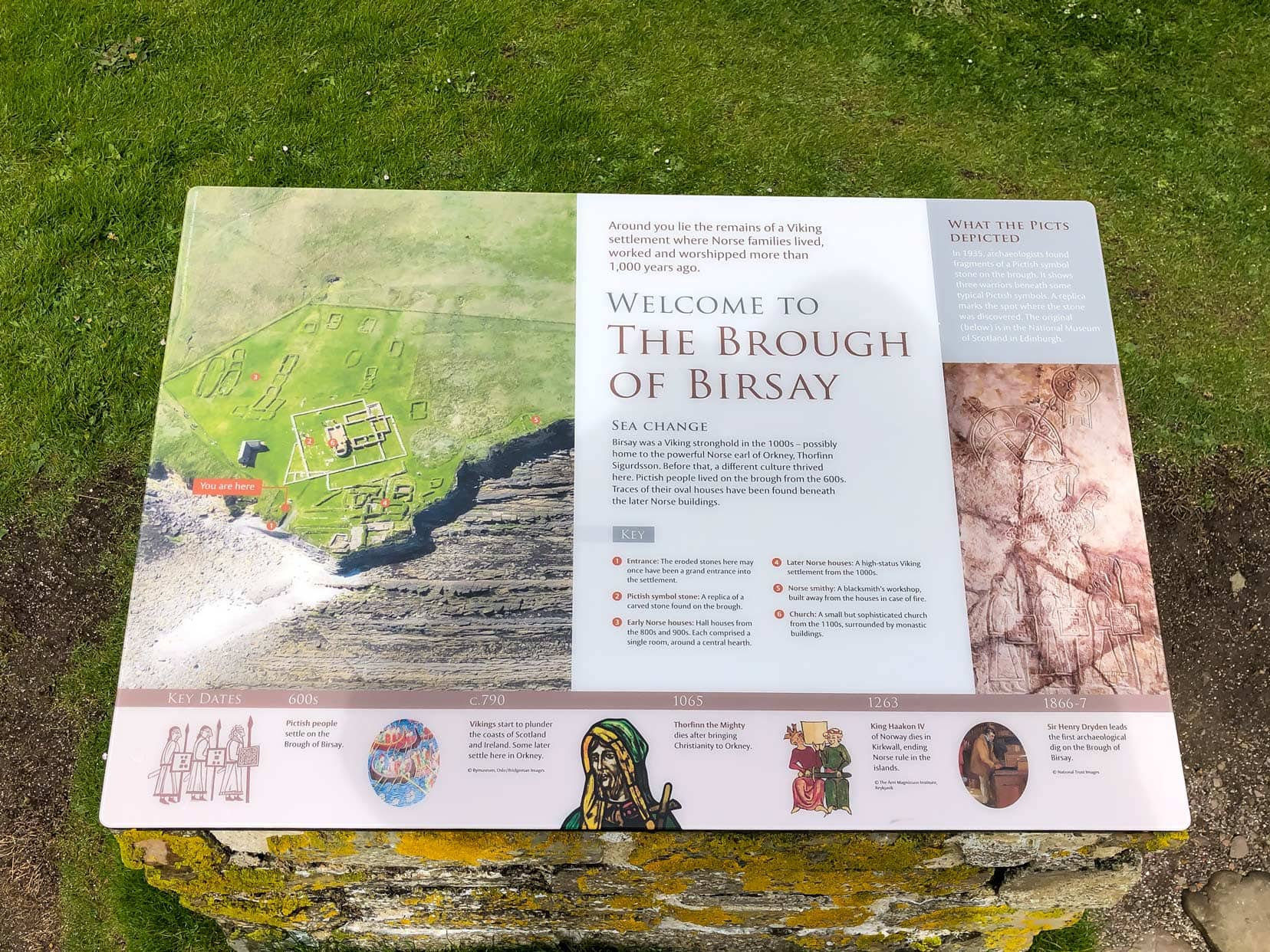
Walking the Brough of Birsay: Exploring the Island’s Heart
Once you’ve timed your visit with the low tide, you’re free to explore the heart of Birsay. The journey begins as you cross the causeway, greeted by a gradual incline that leads from the beach up to the island’s mysteries.
Before you, the landscape unfurls to reveal the remnants of civilizations that once thrived here.
👨👩👦👦 Tip for Families: Enhance your children’s adventure with a downloadable quiz from Historic Scotland about the island’s ruins. It’s a fun way to engage young explorers with the rich history under their feet.
Circling the clifftops takes about an hour. They offer sweeping views and a chance to ponder the lives of those who walked these lands centuries ago.
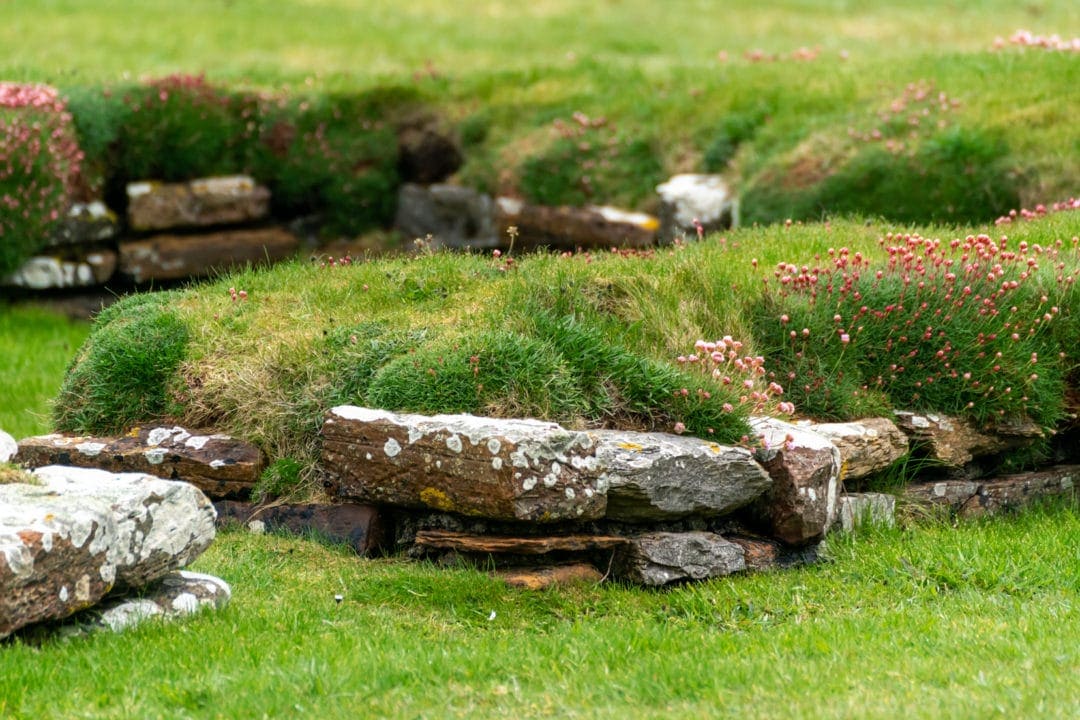
Skiba Geo Bay: A Key Part of the Birsay Island Walk
Another gem in Orkney’s coastal walks, the Skiba Geo footpath takes you past historical and natural marvels.
For an alternative route that’s always accessible, regardless of the tide, follow the signs at the Brough of Birsay car park to the Skiba Geo trail.
This path offers a serene walk alongside Skiba Geo Bay, where history and natural beauty intertwine.
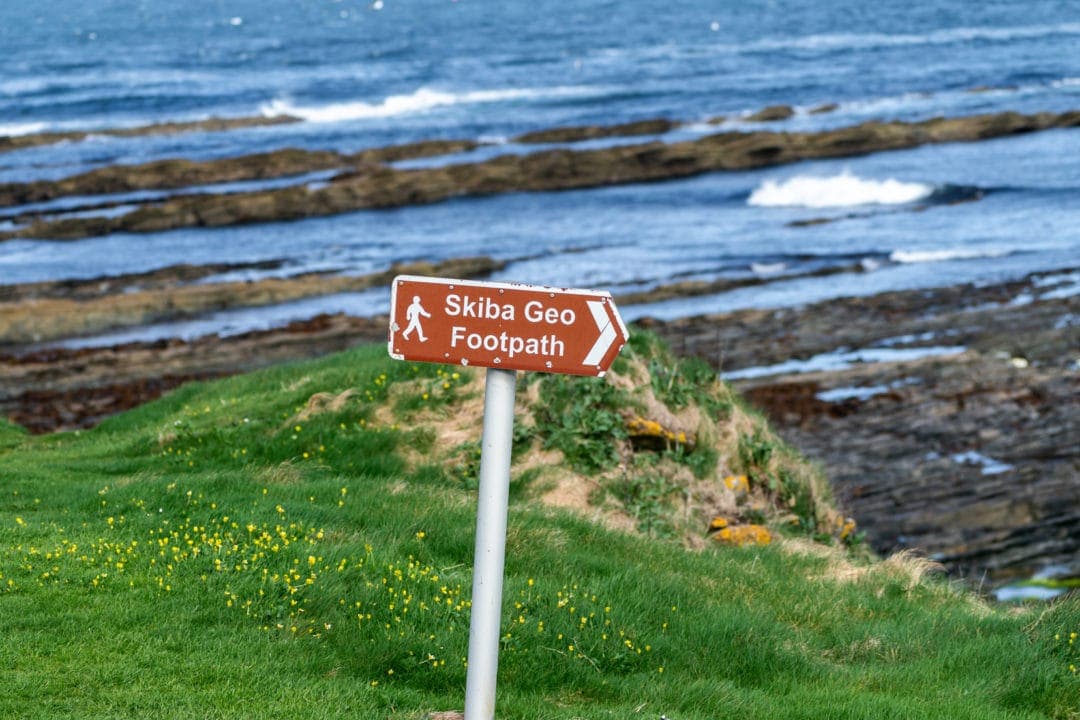
As you venture along this trail, you’ll encounter a beautifully restored 19th-century stone fisherman’s hut, a testament to Orkney’s maritime heritage.
This hut, embedded into the cliffside, is surrounded by ‘nousts’—boat-shaped hollows carved into the landscape for storing boats away from the punishing weather.
A striking feature along the path is a whalebone perched atop a pole, a haunting reminder of a whale washed ashore in the late 19th century.
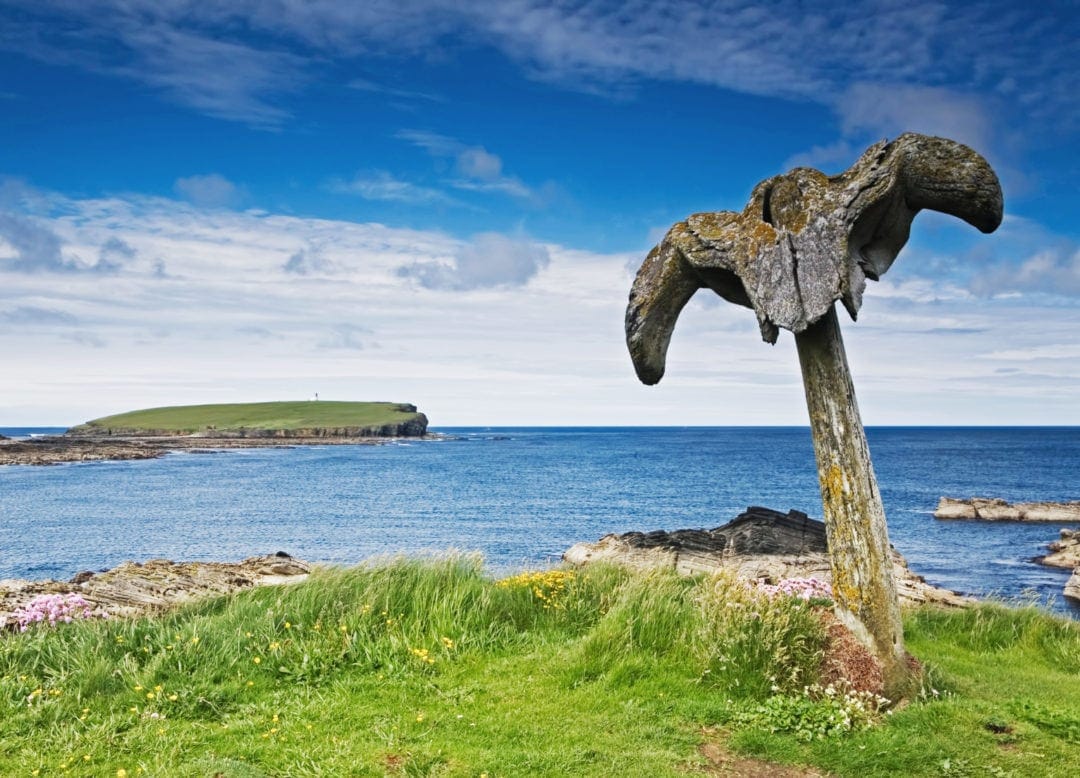
This unique landmark connects Orkney’s whaling past and poignantly symbolizes the island’s close relationship with the sea.
The Skiba Geo footpath, clearly marked from the start, invites walkers into a world where the past is palpable, and the rugged beauty of Orkney’s coastline is on full display.
It’s a walk that reveals the island’s dual nature: its resilience and vulnerability.
Planning a Trip to Scotland.?
- 🚗 Hiring a car? We recommend getting a quote from DiscoverCars
- 🚐 Hiring a campervan? We recommend Motorhome Republic
- ⛑ Arranged your travel insurance? Compare quotes from World Nomads & Safetywing
- 🪪 Order your International Driver’s Licence online here
- 🏩 Booked your accommodation? We use Booking.com to find the best deals
- 🐾 Is someone pet-sitting for you? 🐾 We use and love TrustedHousesitters
- (Get 25% off at checkout for new memberships with our discount code: LIFEJOURNEY25)
Ancient Settlements along the Brough of Birsay Walk
The Brough of Birsay’s history is as captivating as its landscapes, with evidence suggesting habitation as far back as the 6th century.
The Picts, known for their mysterious symbols and skilled craftsmanship, were the island’s earliest inhabitants. Insights from BBC Scotland highlight the significance of these early settlers in Orkney’s rich tapestry of history.
By the 9th century, this strategic outpost attracted Norwegian Vikings, who built their homes atop the ancient Pictish settlement, intertwining Norse culture with the island’s ancient past.
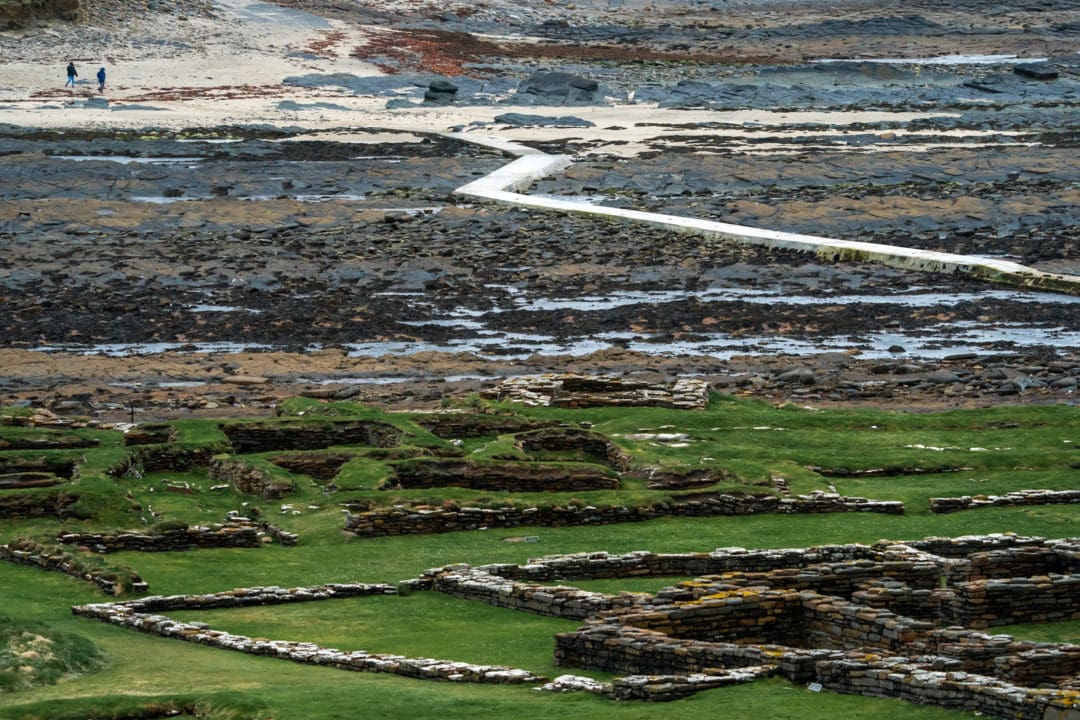
Wandering through the remains, you’ll navigate a labyrinth of walls that once delineated Norse longhouses and a medieval chapel, tangible connections to a vibrant era when Vikings ruled these shores.
These ruins, freely accessible to visitors, offer a rare glimpse into life during the Pictish and Norse dominions.
The visitor centre, managed by Historic Environment Scotland, is open from mid-June to the end of September and provides further insights into the island’s storied past.
Here, you can delve deeper into the lives of those who called the Brough of Birsay home, from the Picts to the Norse settlers, through artifacts and displays that bring their stories to life.
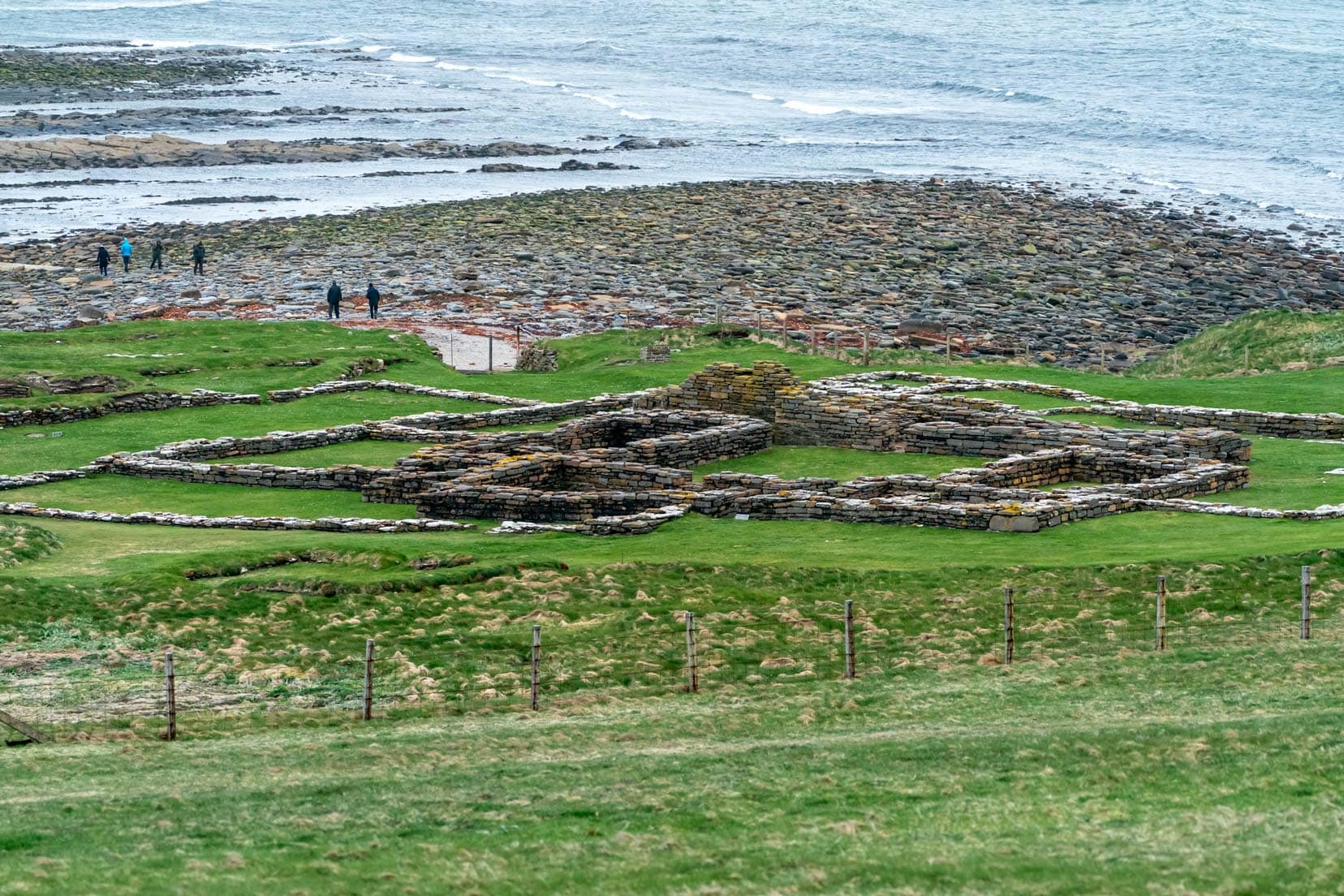
Brough of Birsay Lighthouse
As you follow the cliffs westwards, the path leads you to the Brough of Birsay lighthouse, perched at the island’s highest point.
This lighthouse, designed by engineer David Stevenson in 1925, stands as a testament to maritime safety. It is one of 27 lighthouses he designed across Scotland, including the notable Rattray Head on the Aberdeenshire Coast.
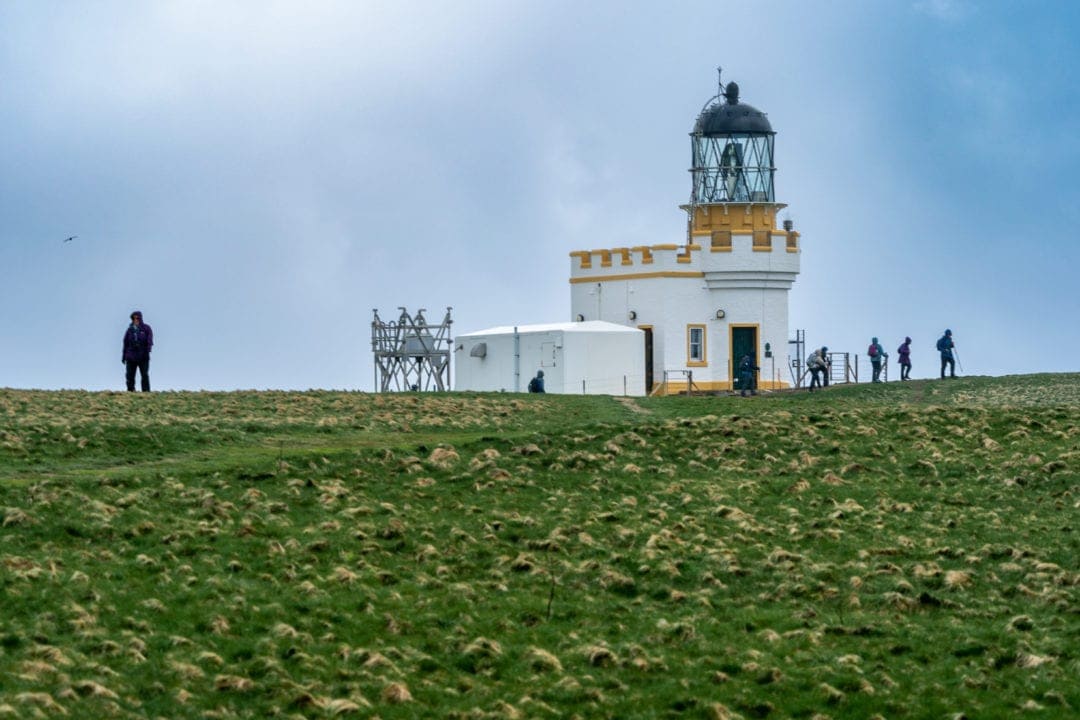
Despite its modest size—11 metres tall—the lighthouse’s unique castellated design and location 52 metres above sea level make it a prominent feature against the backdrop of the Brough’s cliffs.
Innovatively powered by 36 solar panels and four wind turbines, it blends tradition with modern sustainability.
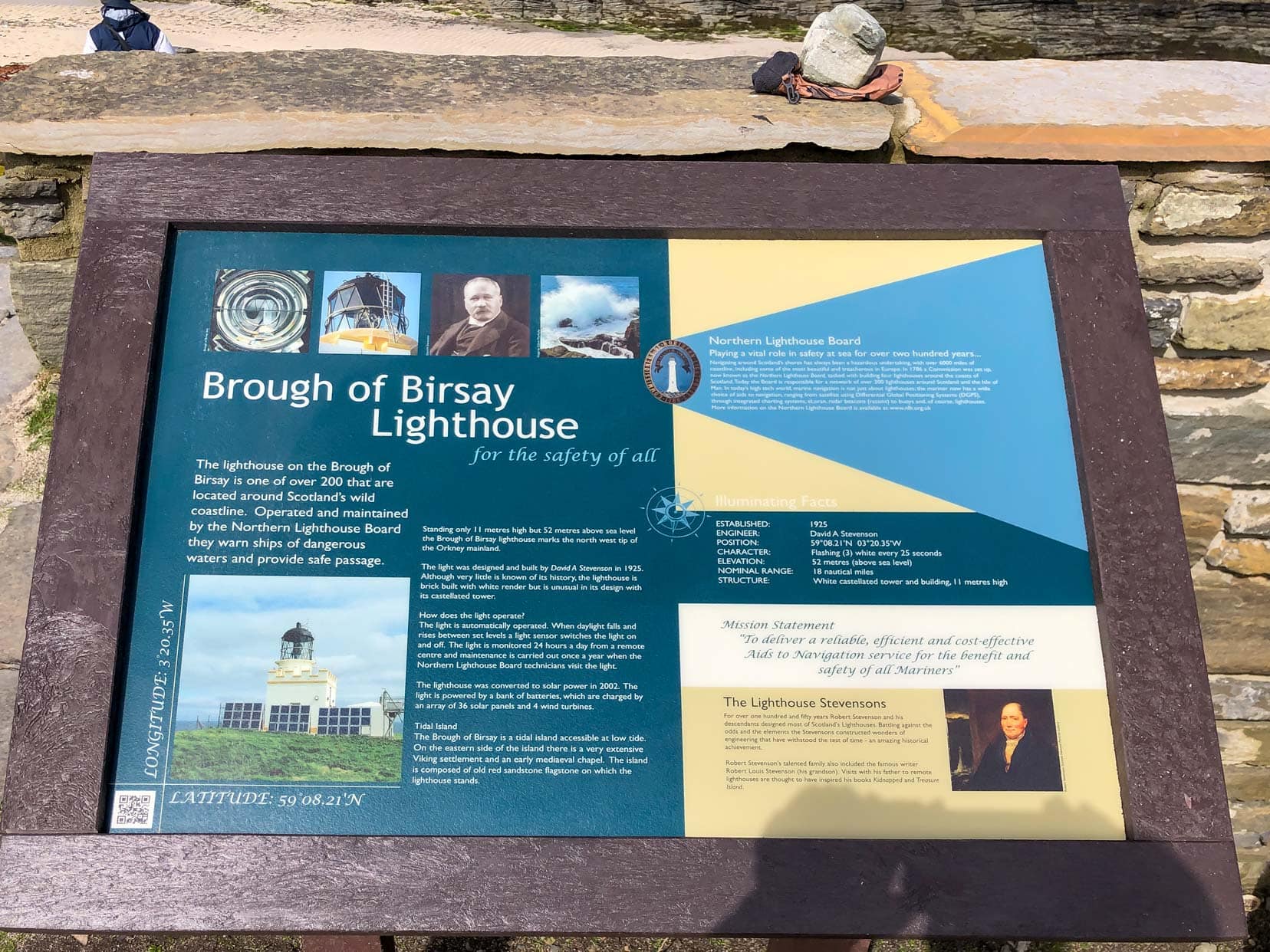
Reaching the summit offers breathtaking views and an opportunity for ‘hill bagging’ this Tump—a hill defined by its distinct separation from surrounding tops by at least 30 metres.
To log this accomplishment, hop over to the Hill Bagging site and add a memorable achievement to your visit. Here’s a screenshot of our and others’ logs of reaching the Brough of Birsay summit.

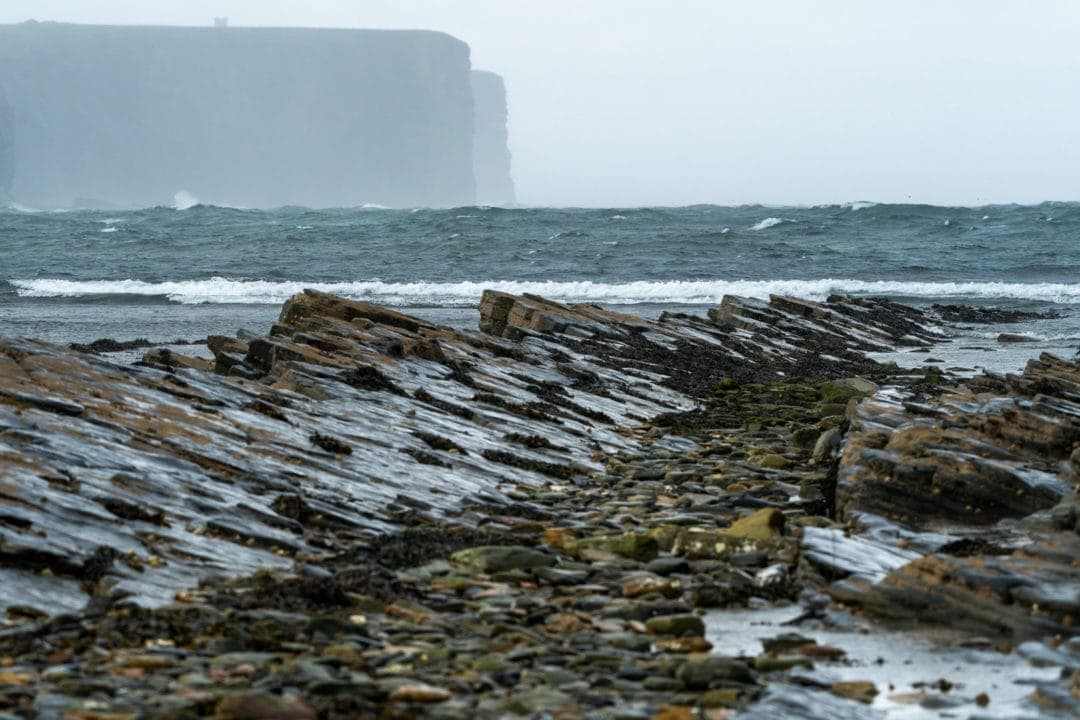
Capture the Beauty: Photography Tips for Birsay
For photography enthusiasts, the Brough of Birsay presents countless opportunities to capture Orkney’s essence.
Just after sunrise or before sunset, the golden hour offers magical light for capturing the rugged landscape and historical ruins. Still, you are guided by the tide times allowing access to the island.
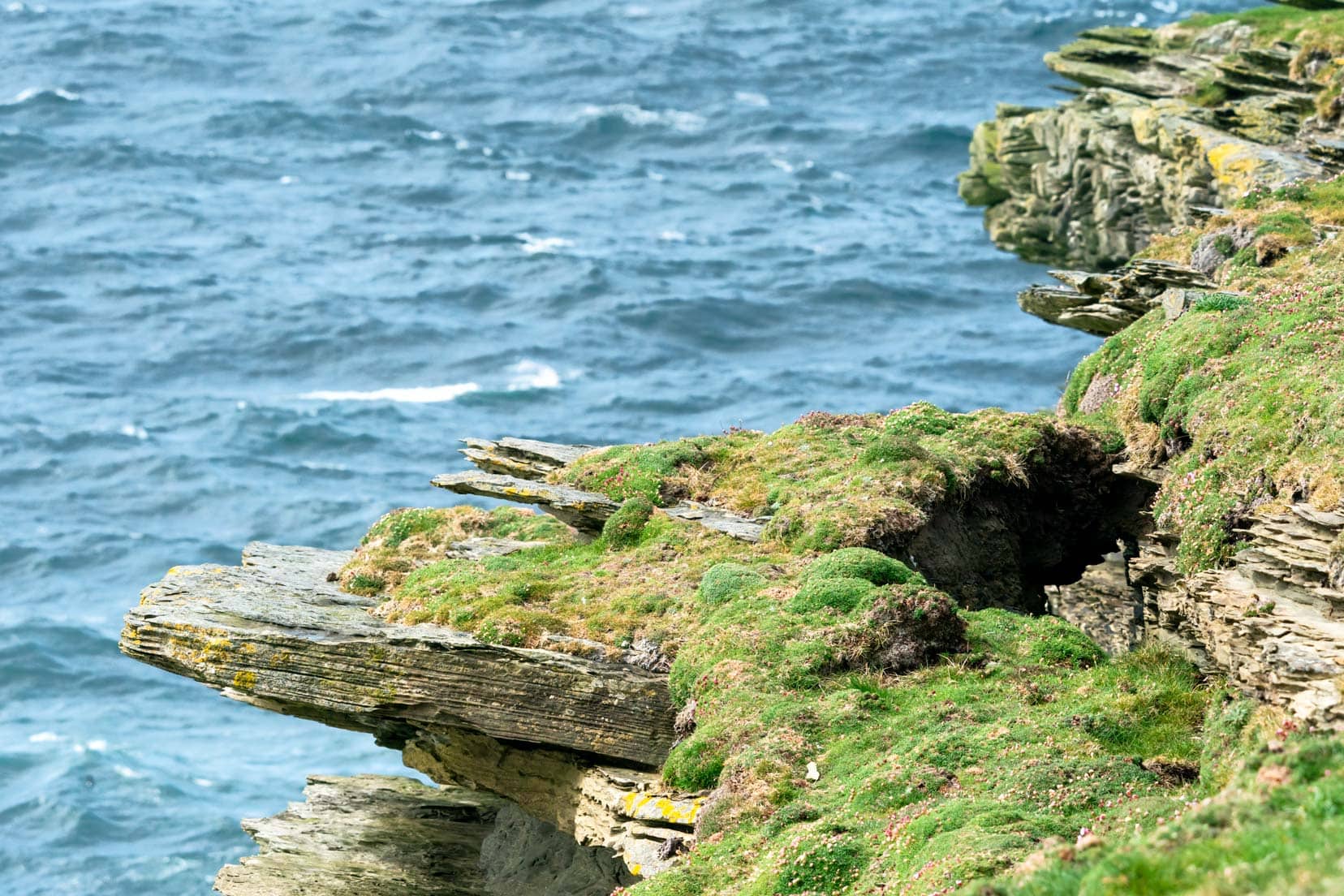
A tripod can be invaluable for landscape shots; however, be aware of the windy conditions, which is invariably the case on Orkney! I’ve replaced the tripod rubber footings with spikes that sink into the ground, providing stability.
Look at our post on our photography gear for a detailed look at the equipment we have while travelling.
For wildlife photography, a telephoto lens is recommended to capture detailed images of seabirds without disturbing them. Another benefit is maintaining a safe distance from the steep cliffs while taking your shots.
Check out our photography article here for extra tips on taking photos while travelling.
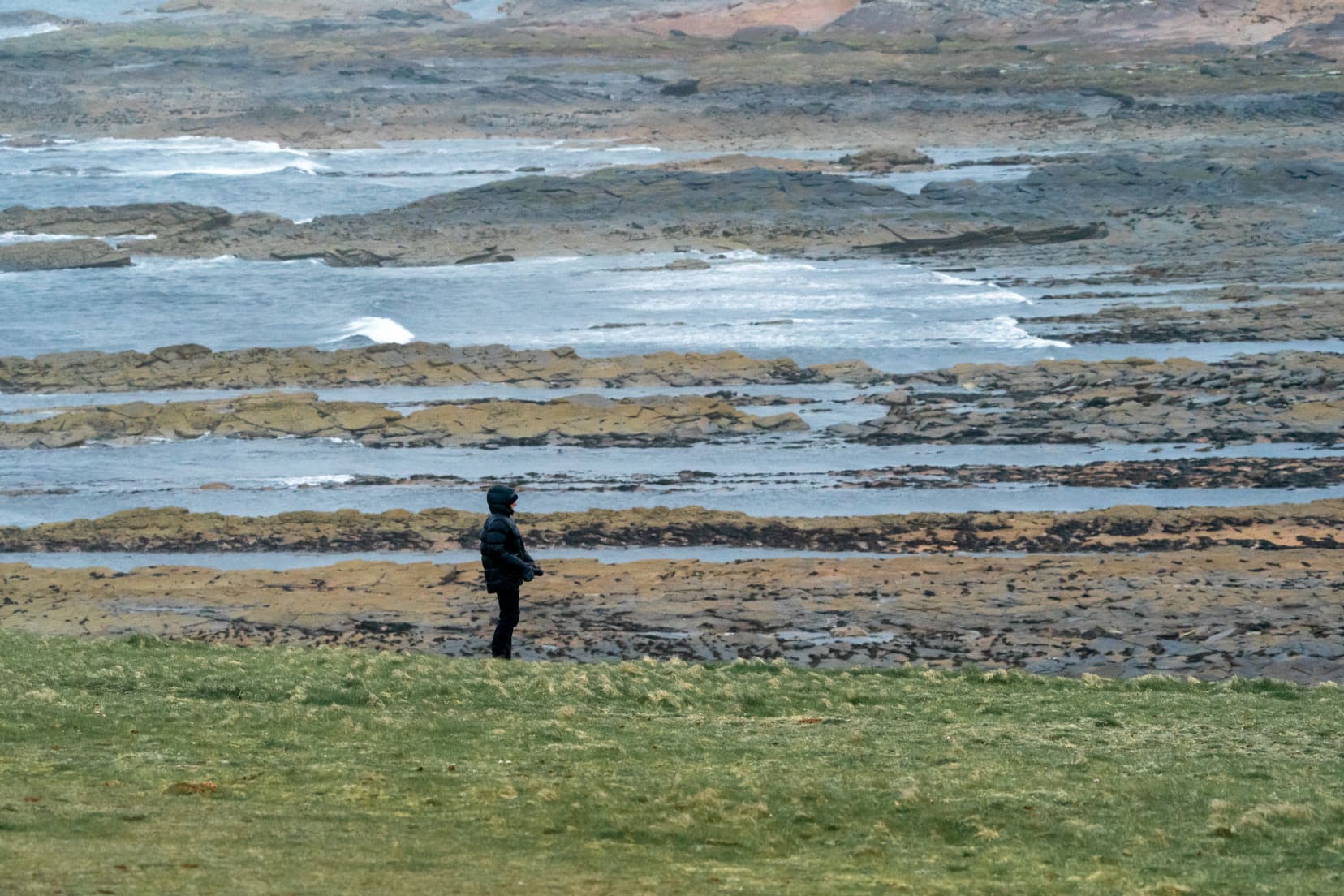
Brough of Birsay Wildlife to Spot on Your Walk
The Brough of Birsay Walk is not just a historical journey; it’s also an opportunity to engage with Orkney’s vibrant wildlife, making it a must-do for enthusiasts of Orkney coastal walks.
The cliffs of the Brough of Birsay are ideal habitats for seabirds, especially during their spring nesting season.
As you explore, keep an eye out for gannets, razorbills, shags, guillemots, and the charming puffins. These birds choose the rugged cliffs of Birsay as their breeding grounds, offering you a spectacular display of Orkney’s avian diversity.
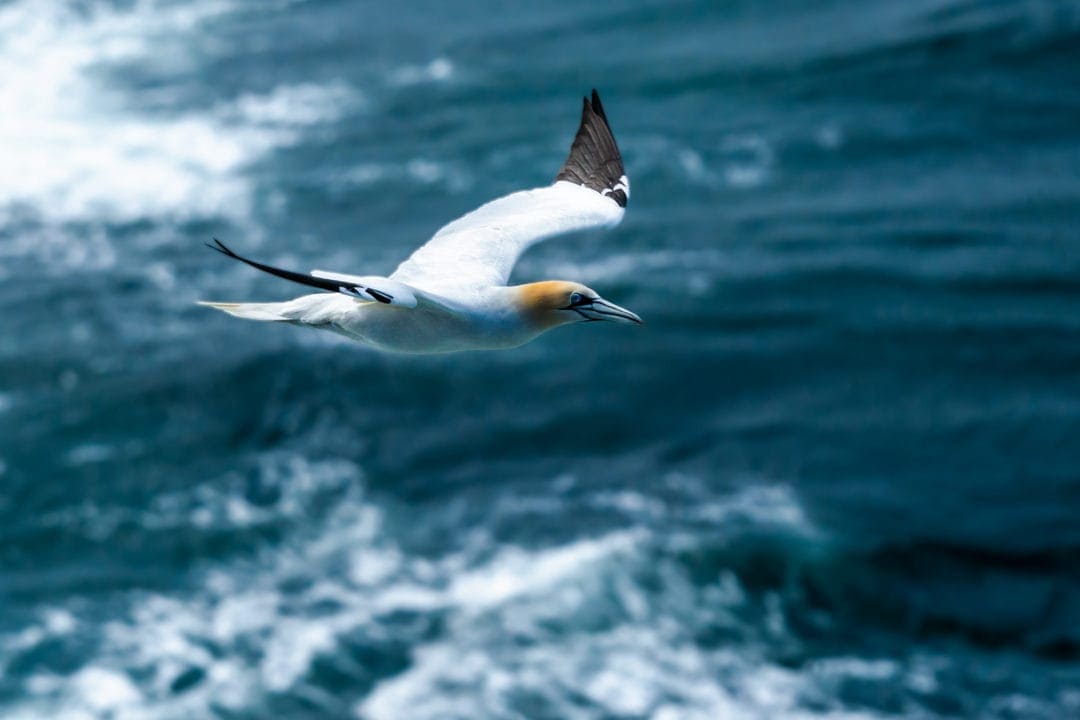
For those interested in learning more about the seabirds, particularly gannets, consider reading our detailed account of Gannets Galore at Troup Head, Aberdeenshire, Scotland.
We spotted a male and female eider duck relaxing at the top of the brough and plenty of guillemots, razorbills, and gannets soaring around the cliffs.
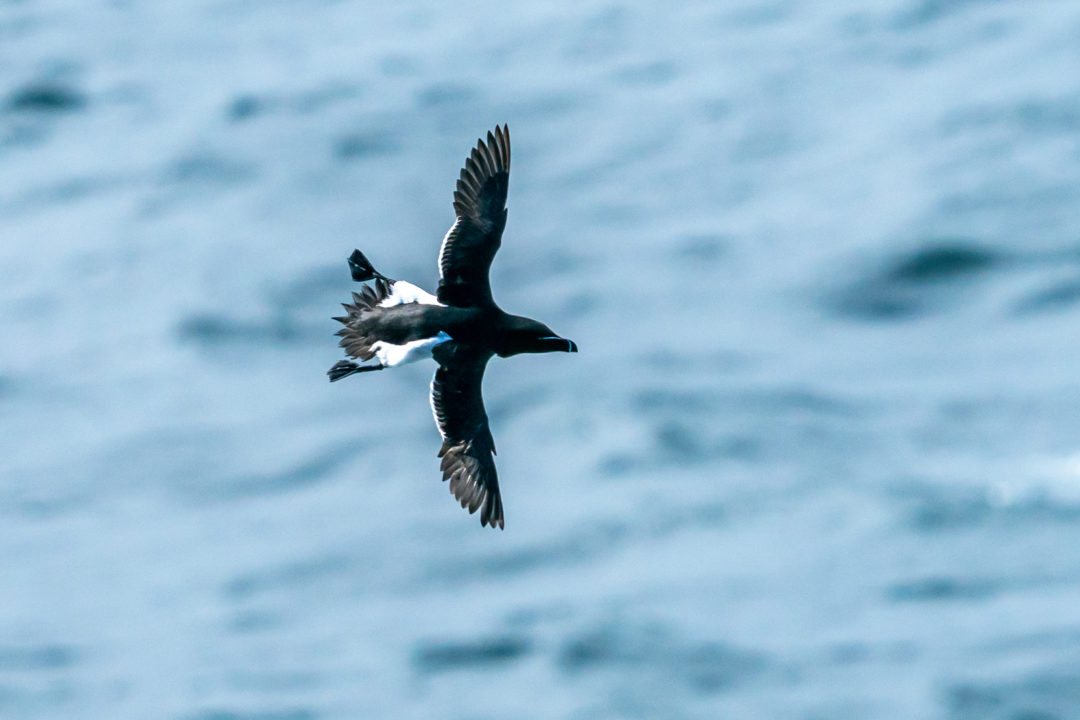
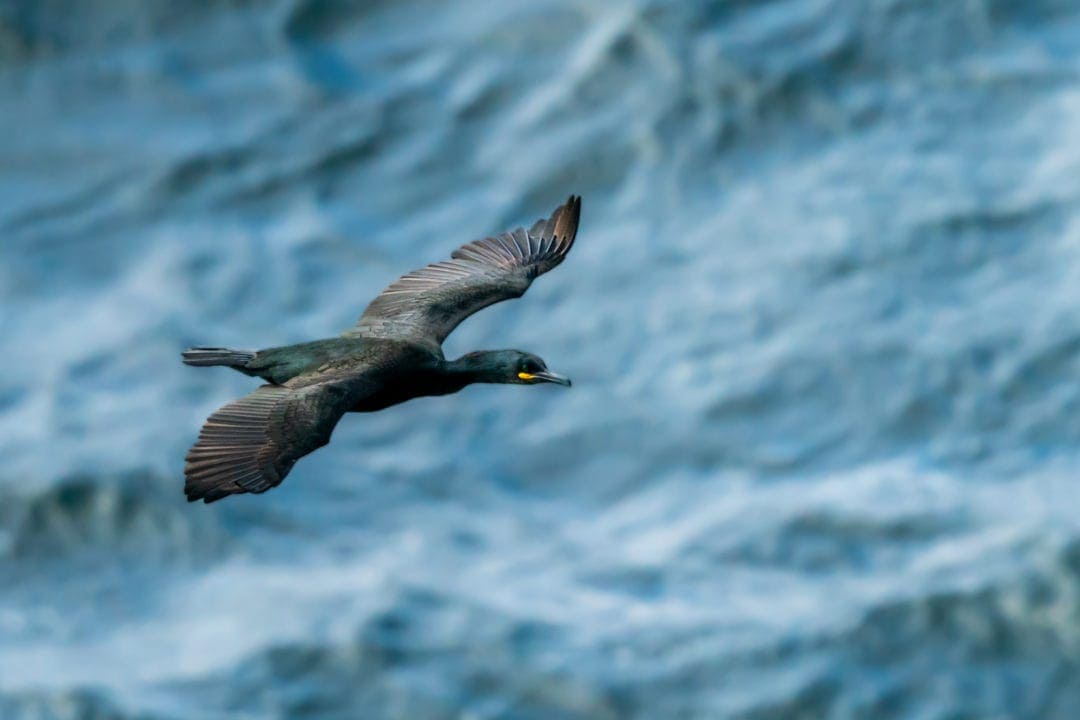
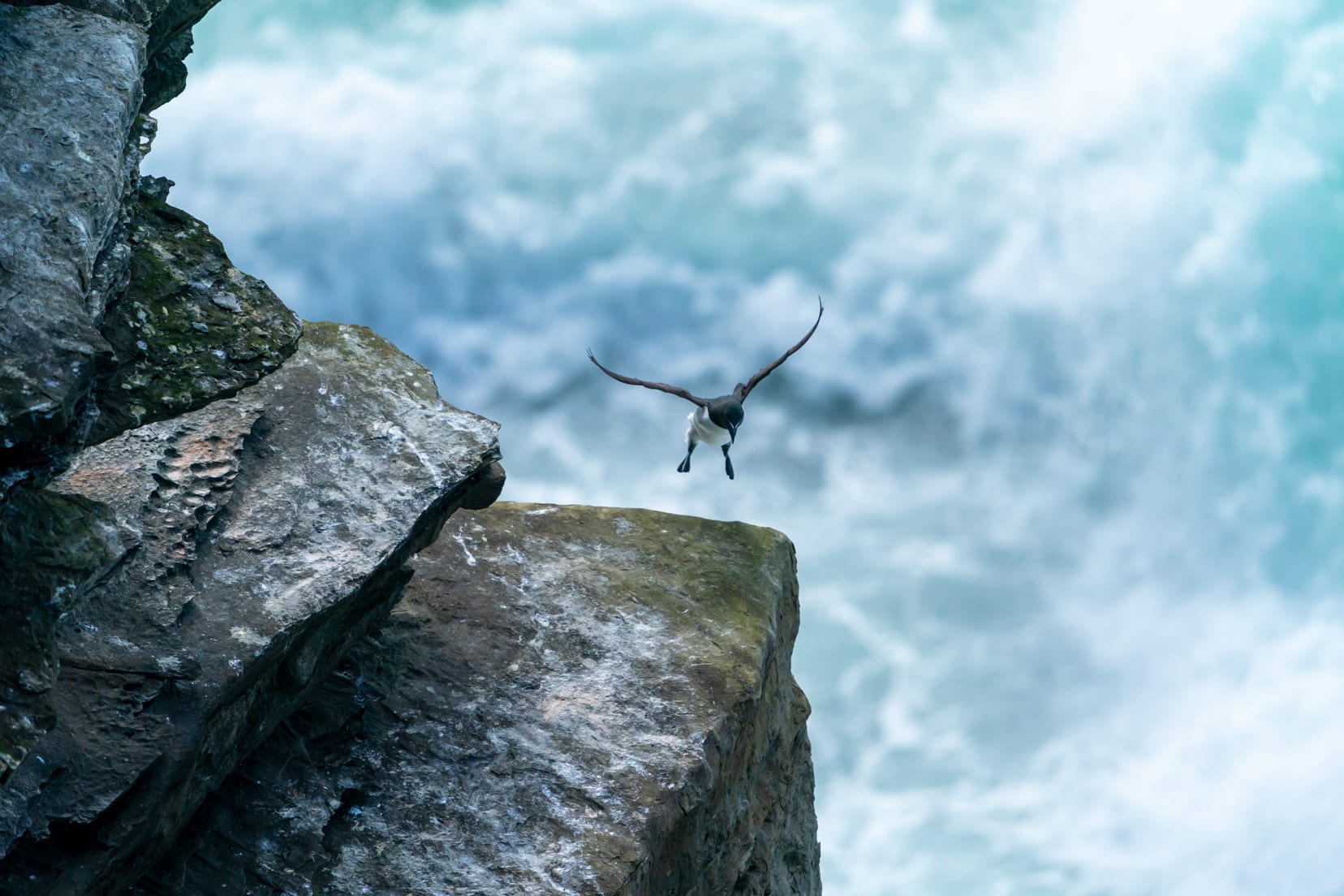
In addition to the seabirds, the waters around the Brough are teeming with marine life.
To enhance your wildlife-watching experience, keep an eye on the sea below the cliffs for a chance to spot orcas, minke whales, dolphins, and seals.
The best times to spot orcas and minkewhales are between May and August, with seals and dolphins visible throughout the year.
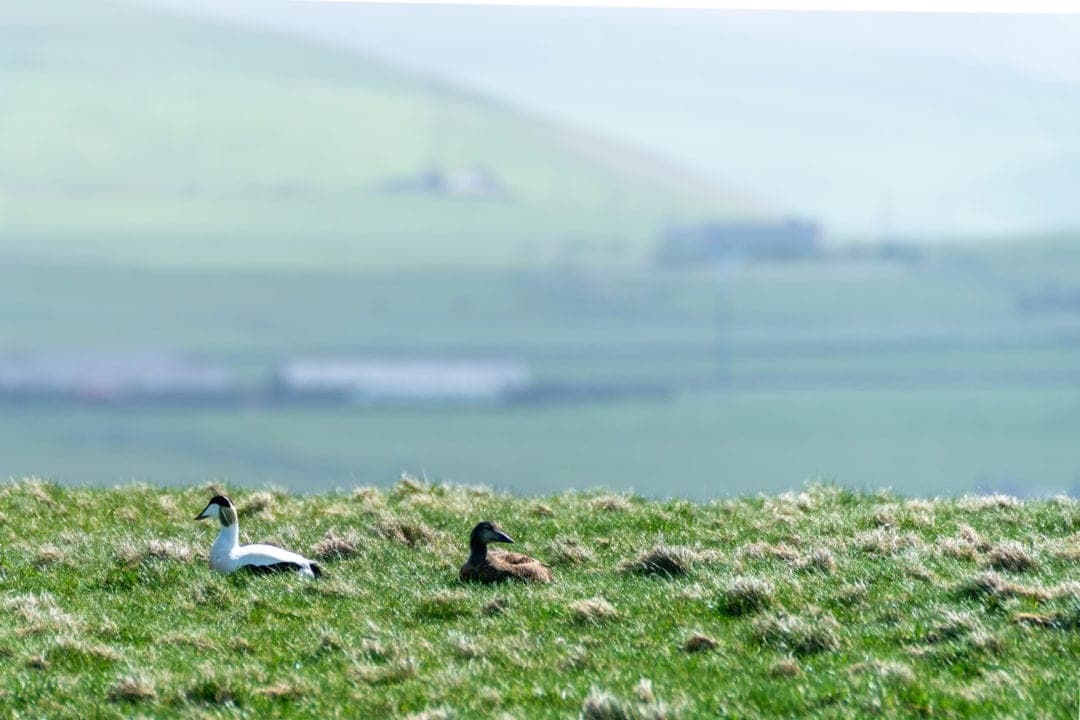
Brough of Birsay Puffins
The Brough of Birsay is renowned as one of the best places on mainland Orkney to spot puffins, affectionately known locally as “Tammie Norries.”
These colourful seabirds grace the island from late April to the beginning of August, spending the rest of the year at sea.
Their preference for burrow-nesting makes the grassy areas atop the cliffs prime spots for observation.
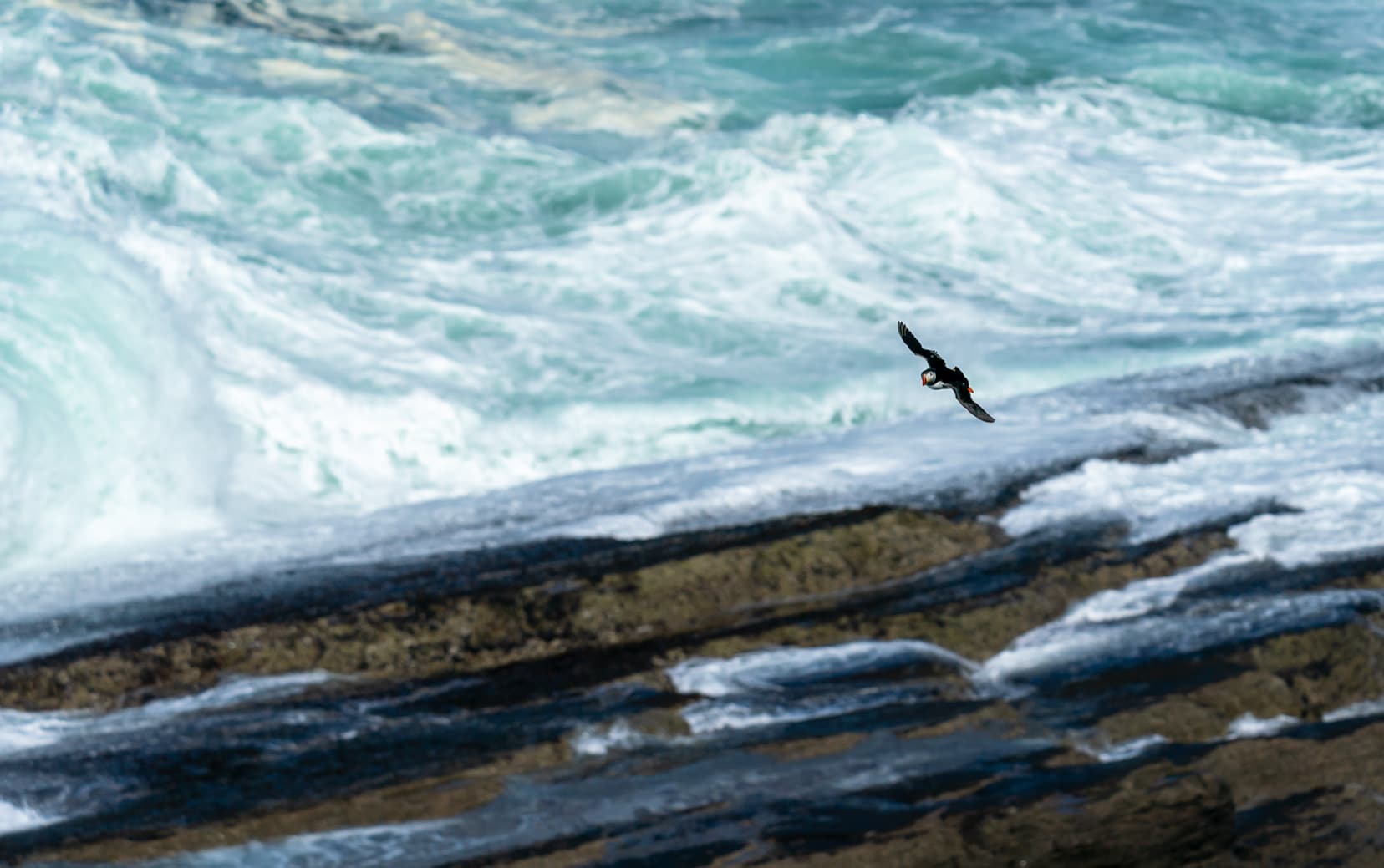
During our exploration, we captured shots of puffins near the lighthouse cliffs, although they were elusive on the rocks.
Locals tipped us off that the island’s east side, just around the corner from the Viking settlement, is a frequent puffin spotting area.
For enthusiasts observing these seabirds, it is advisable to focus on the island’s grassy cliff tops. Puffins prefer burrows for nesting, which sets them apart from many seabirds that nest on cliff ledges.
🐧 Puffin Enthusiasts’ Note: Our fascination with these ‘colourful clowns of the sea’ isn’t limited to Orkney. We’ve also enjoyed watching puffins at Handa Island on the west coast of Scotland and Skomer Island in Wales. For a closer look at these charming birds, check out our experience with Plentiful Puffins on Skomer Island.
Additionally, Westray Island, north of the mainland Orkney, offers another popular puffin nesting site, with Stanger Head and Castle O’ Burrian being particularly noteworthy locations.
The Brough of Birsay is a haven for birdwatchers, especially during the breeding season from April to July, when the cliffs buzz with seabird activity.
Observing these magnificent creatures without disturbing them requires keeping a respectful distance and using binoculars or a long lens.
Conservation efforts by local wildlife organizations focus on protecting these nesting sites, and by adhering to designated paths, visitors play a part in preserving the natural habitat of Orkney’s avian residents
Floral Wonders of Brough of Birsay

The Brough of Birsay not only captivates with its historical and wildlife marvels but also enchants with a vibrant display of wildflowers, particularly during the spring and summer.
During our visit in mid-May, the island was adorned with:
- Pink Thrift: This charming flower blankets areas of the Brough in a soft pink hue, thriving in the salty sea air.
- Yellow Bird’s-Foot Trefoil: Often likened to a splash of sunshine, the yellow bird’s-foot trefoil dotted the landscape, creating a striking contrast against the rugged backdrop.
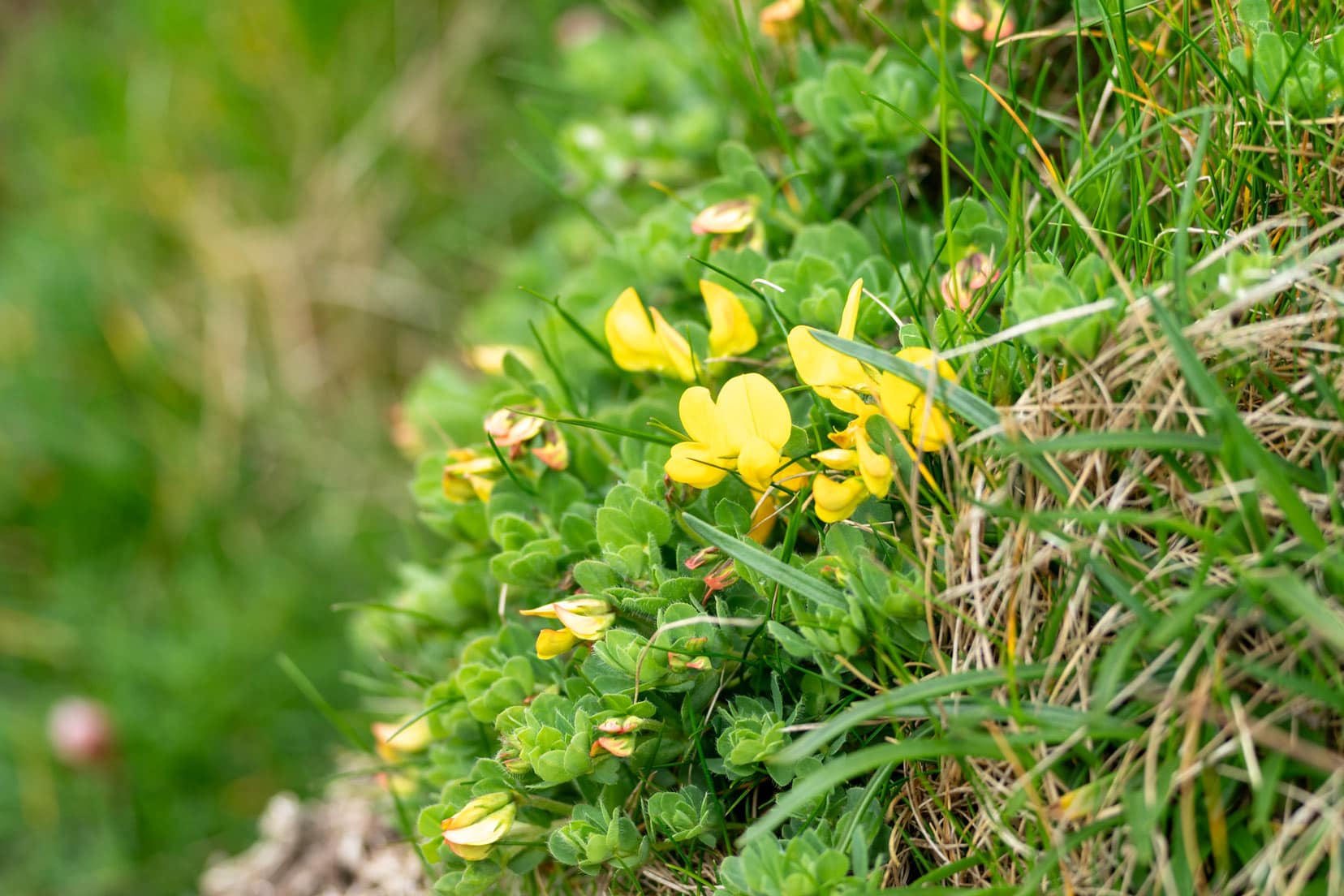
While we were mesmerized by the abundance of thrift and trefoil, the Brough of Birsay is also home to Blue Spring Squill, a delicate flower that adds a touch of blue to the spring palette. However, we didn’t spot it during our visit.
These flowers not only beautify the landscape but also support a variety of pollinators, playing a crucial role in the local ecosystem.
Whether you’re a botany enthusiast or simply appreciate the beauty of wildflowers, the Brough of Birsay’s floral display is a delightful complement to its historical and natural attractions.
If you love spring flowers, don’t miss the beautiful display of bluebells at Binscarth Woods on Orkney.
Getting to Brough of Birsay
Planning your visit to the Brough of Birsay starts with understanding how to get there and what to expect.
Birsay Orkney Map
For a visual guide on reaching the Brough of Birsay, here’s a map to help you navigate:
Driving to the Brough of Birsay
If you’re starting from Kirkwall, the drive to Brough of Birsay takes about 30 minutes.
For those interested in making the journey part of the adventure, consider the scenic westerly route. This path leads you past the ancient Stones of Stenness and the majestic Ring of Brodgar, adding historical depth to your trip.
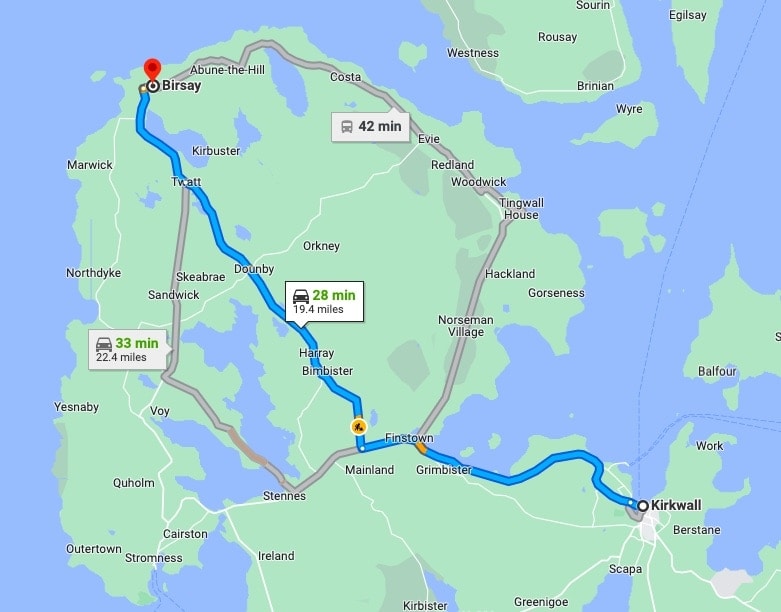
Parking at Brough of Birsay
Upon arrival, parking is conveniently located at Point Buckquoy, just opposite the island. Here, steps lead down to the beach, where the iconic zig-zag concrete causeway begins your final approach to the island.
Can You Walk to Brough of Birsay?
The Brough of Birsay is accessible on foot via a 100m concrete causeway from mainland Orkney, but only during low tide.
Starting from the car park at Point of Buckquoy, a short walk across rocks and seaweed leads you to the causeway.
Caution is advised as the path can be slippery—I’ve experienced how easy it is to lose your footing here.
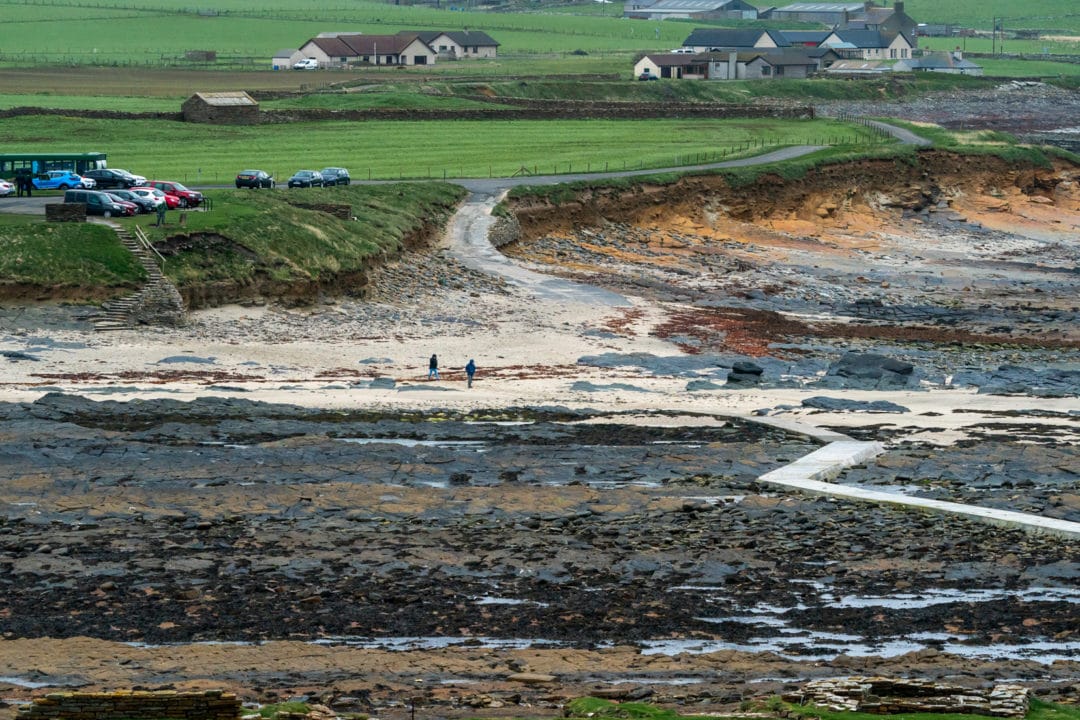
When Can I Cross to Brough of Birsay?
The crossing is restricted to two hours before and after low tide, necessitating careful planning.
For the most accurate tide times, consult the UK Met Office or grab a leaflet with weekly tide times from the Kirkwall Tourist iCentre.

How to Check the Tidal Times for the Brough of Birsay Walk
The table below is taken from the UK Met Office and shows tide times for Brough of Birsay on a certain day.

It shows that on the 27th of May, the Low tide times are at 02:12 and 14:40.
You aren’t going to want to visit at 2 am, so the only time you could cross to and from Brough of Birsay would be between 12:40 and 16:40 — that’s two hours on either side of the low tide time.
When you plan your crossing of the causeway to the island, leave enough time to explore the island and get back across.
You basically have a four-hour window.
Explore Orkney’s Rich History with a Local: Historic Orkney Tour
Join a local islander for a bespoke journey through Orkney’s captivating landscapes and historical sites. This private tour offers a personalized experience, showcasing Orkney’s main attractions and hidden gems, all from the comfort of a private vehicle.
Tour Highlights:
- Duration: 4 hours, with the flexibility to extend and customize.
- Features: Free cancellation, reserve now & pay later
- Experience: A mix of scheduled stops and optional visits, including the Brough of Gurness, Brough of Birsay, Yesnaby cliffs, and more.
- Personalized Experience: Enjoy the freedom to explore at your own pace, with guidance and insights from a lifelong Orkney resident.
- Includes: Pickup from arrival destinations, transfers, customizable itinerary, local insights, and waterproofs if needed.
⭐️ Find out more or book a tour here
Extra Information on the Brough of Birsay
Sustainability and Preservation
Visitors are encouraged to follow the Leave No Trace principles. Minimizing our impact, we help preserve Birsay’s natural beauty and archaeological integrity for future generations.
Look for ‘Goatie Buckies’ on the Beach
While exploring the sandy stretches of Birsay beach, look for cowrie shells, affectionately known locally as ‘Goatie Buckies’.
These shells carry a piece of local folklore with them. It’s said that keeping a Goatie Buckie in your purse ensures you’ll never be without money.
Similar to those found at John O’Groats, these shells have become rarer, making finding one even more special.
The beach’s rock pools also offer a delightful exploration opportunity.

How do you pronounce Brough of Birsay?
For those wondering about the correct pronunciation, ‘Brough’ is said as ‘brock’, and ‘Birsay’ as ‘burrsay’. Knowing this can help you feel more like a local as you explore.
Birsay Earl’s Palace
Just across from the Brough lies the ruins of the Earl’s Palace, a once-grand residence of Robert Stewart, the 1st Earl of Orkney, and his son, Patrick Stewart, the 2nd Earl.
Their stories are as compelling as the ruins are striking, marked by tyranny and the forced labour that built this and other structures.
Despite its sombre history, the site offers a fascinating glimpse into Orkney’s past.
Visiting the Earl’s Palace in Birsay is free and recommended to complete your journey through the area’s rich history.

Local Tea Rooms by the Palace
The Birsay Bay Tearoom, is just near the Earl’s Palace and the perfect spot to stop for some coffee and cake.
- Winter Opening Hours: Friday to Sunday, 10:30 AM – 4:00 PM
- Summer Opening Hours: Thursday to Monday, 10:30 AM – 4:00 PM
Check their Facebook page for the most current opening hours and any special offerings during your visit.
Brough of Birsay… That’s a Wrap
The Brough of Birsay Walk encapsulates the essence of Orkney’s beauty and history, making it an unforgettable part of any Orkney island walk.
The Brough of Birsay offers a remarkable blend of history, wildlife, and breathtaking coastal walks.
Whether you’re tracing the steps of ancient civilizations, observing the vibrant dance of seabirds, or simply soaking in the wild beauty of Orkney’s landscapes, Birsay promises an enriching experience.
The spring and summer months, in particular, bring an added spectacle of nature with nesting seabirds and a carpet of wildflowers.
For more on the best seasons of Orkney, head over to our post on the best times to visit Orkney.
This unique destination encapsulates the spirit of Orkney, inviting visitors to connect with both the past and the present in an unforgettable setting.
If you are planning your Orkney travels – make sure to download our FREE travel planner below:

Pin and Save for Later

Read More:
- Orkney Magic: Bluebells at Binscarth Woods
- Newburgh Seal Beach, Aberdeenshire, Scotland
- Scotland Travel Guide
Planning Your Travels?
These are the travel resources we recommend and use when planning our trips.
- 🚘 Car Hire: We use DiscoverCars.com
- Motorhome/Campervan Rental: We highly recommend the Motorhome Republic
- 🪪 Order your International Driver’s Licence online here
- 🛏 Book Accommodation: We use Booking.com to find accommodation that suits our budget
- 🐶 Pet Sitting/Pet Sitters: Check Out TrustedHousesitters here (Use our Discount code: LIFEJOURNEY25 for 25% off. )
- Activities and Experiences: Get Your Guide and Viator
- Travel Insurance: Safetywing or World Nomads
- 🥾 Travel Gear and Accessories: Check out our top picks here — Lifejourney4two page on Amazon
For a more thorough list, visit our Travel Resources page here.


